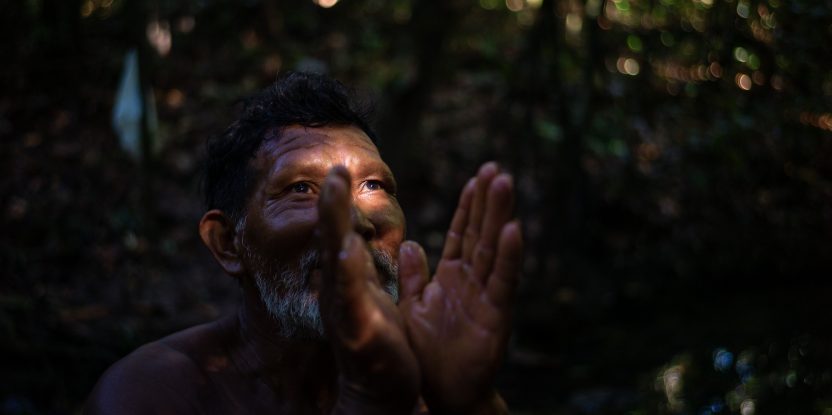
“In the hushed pre-dawn darkness, the first sounds of daylight begin to filter through the forest understory. As the trees take shape against faint light in the eastern sky, a troop of Guianan red howler monkeys awakens with a mighty roar, their voices fading in and out on the soft breeze. A marail guan, the namesake marudi of these hills, launches from a high perch with a few loud flaps, displaying to a female hidden in the canopy below. As the last of the night’s frogs retire to their daytime haunts, a chorus of birds – woodcreepers, forest-falcons, toucans and antpittas – swells amid the shadows. The first sunlight reaches the highest canopy crowns, where flowers begin to swarm with an army of insects eager for nectar. Daylight advances, and the forest comes alive.”
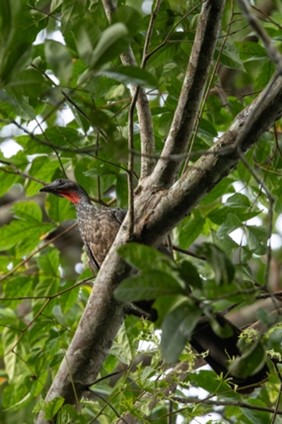
The Marail Guan can be found in abundance in the Karaawaimin Taawa area. ©FAO/Marlondag
The compelling paragraph above describes the experience of international bird scientist, Brian O’Shea, waking up in the camp in Karaawaimin Taawa, a remote mountain range in the rainforests of Rupununi in southern Guyana. It appears in an upcoming book on a community-led bio-cultural assessment, which was carried out via a three-week-long expedition involving local and international wildlife experts, in March 2022.
The region is one of the biodiverse ecosystems in the world, but prior to this body of work, there was no comprehensive assessment of the flora and fauna therein. It’s traditional territory of the Wapichan Indigenous people; presently, though, their rights to the land are not legally recognized. That’s important, because gold mining is being considered in the Karaawaimin Taawa area, threatening water systems, biodiversity, and community livelihoods.
“Community members fear that they will not be able to drink the water and eat the fish because of mercury contamination, which has already happened in some places due to mining,” said Andrew Snyder, who is the Key Biodiversity Area Coordinator at Re:Wild, and one of the eight international researchers who joined the expedition.
In that context, leading Indigenous organization South Rupununi District Council (SRDC) has been taking steps to ensure that their homeland’s natural treasures are seen and valued. With support from the Sustainable Wildlife Management (SWM) Programme, a major international initiative which aims at improving wildlife conservation and food security, SRDC started the organization of a biodiversity expedition to the area. SWM’s role was key in developing a collaborative network between community experts and scientists and ensuring that local knowledge was integrated in all phases of the expedition. “The idea was to go in and collect as much baseline biodiversity data to supplement the knowledge that the locals already have about this area to make a very thorough comprehensive case for why this area should not be opened up for gold mining,” said Snyder.
“What we’re hoping is that we have enough strong data, and enough of an international media push, to ensure that local indigenous communities can continue to benefit from this resources and be responsible for protecting their own land,” he said.
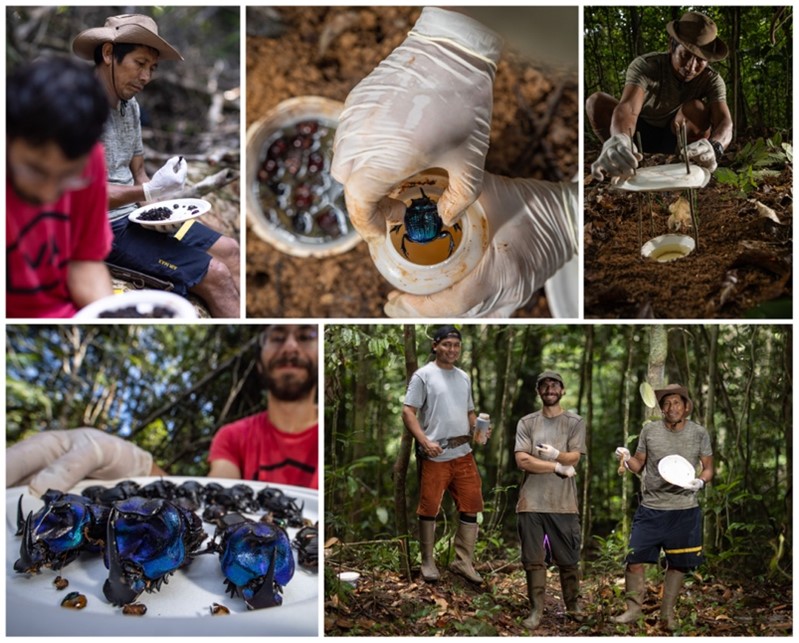
Local experts working alongside international scientists to gather extensive data of the taxa of dung beetles in the Karaawaimin Taawa area. ©FAO/Marlondag
Little-charted territory
For the international researchers, the expedition was exciting and fruitful – if at times difficult given accessibility challenges, bad weather, and abundance of mud. “This is a very remote and wild area,” said Brian O’Shea, a collections manager in ornithology at the North Carolina Museum of Natural Sciences in the United States; “and any time you go somewhere where there aren’t many people, you tend to find a lot of wildlife.” O’Shea was part of the team focusing on birdlife, which also included a local bird expert, Asaph Wilson (see our Q+A with him here). “We found high diversity, and a very much intact bird community,” he said. Many of the species the team found were “very common, and not at risk now – but mining would inevitably lead to tragedy in short consequence,” he said.
Snyder, for his part, focused on getting a snapshot of the amphibian and reptile species in the area. “Basically, I would go out every single morning for several hours, and every single night for four, five, six hours, to do general opportunistic surveys,” he said. “I would target as many different habitats that were around our campsite as possible – swamps, rivers, forests away from the creek, adjacent to the creeks. When all’s said and done, we should be able to make estimates of the total number of species that live within the area, and of how many species we didn’t find that might occur there, based on the number of different species. So, I will be making estimates of abundance for particular species, as well as a general diversity number.”
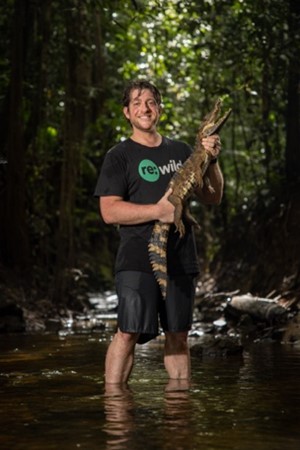
International scientist Andrew Snyder holds up a smooth-fronted caiman caught during the assessment. ©FAO/Marlondag
At lower elevation areas, the team encountered amphibians and reptiles that could be considered relatively widespread – although as Snyder noted, “at least with amphibians, what we’re finding these days is that what were once considered widespread species actually consist of multiple species masquerading under one name…. So several of what I encountered on this trip, I know full well within the next few years are going to be considered smaller species.”
In the extremely isolated upland areas, the scientists found – as expected – higher levels of endemism. There, they encountered a high number of yellow-footed tortoises [Chelonoidis denticulatus], which are listed as vulnerable on the International Union for the Conservation of Nature (IUCN) Red List of Threatened Species.
They also recorded a species of snake that had not yet been recorded for Guyana, and several species of frogs which “may well be entirely new species to science; or they may be species that have been recorded in other countries and Brazil, and just have not yet been recorded here,” said Snyder; “genetic analysis is required to tease that out.”
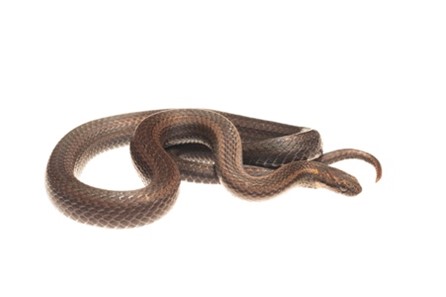
This Short-nosed Leaf Litter Snake is a new discovery to Guyana. ©Andrew Snyder
While such analysis remains to be done, Snyder – who has traveled extensively across Guyana over the past 11 years and surveyed a lot of different locations – said that “in just a few short days on this trip, it was immediately apparent that this location is incredibly biodiverse. It was something that that you noticed on the ground, rather than having to go back and look at your data afterwards.”
Aside from the taxonomic findings, the scientists spoke highly of the process itself, and the opportunity to exchange knowledge with local experts on the trip. “We don’t often get the opportunity to truly collaborate,” said O’Shea. “Here, we felt like we were transferring useful skills amongst ourselves– we all showed a real desire to learn from each other.” The local experts were essential to the success of the assessment, given their experience in the terrain, their knowledge of local species and their sensorial capacities were essential whilst scientists contributed with standard methods and tools for recording observations and data.
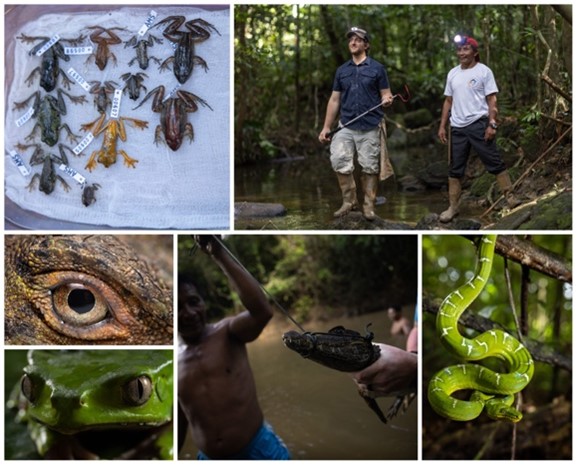
The reptiles and amphibian team, like the other taxa’s, consists of local experts and international scientist. ©FAO/Marlondag
It was also apparent that the assessment ought to be seen as just one step in building up a comprehensive picture of biodiversity in the area. “The very last day, we recorded three new species that we hadn’t recorded during the previous days,” said Snyder; “I can only imagine how many more species occur there that we just didn’t have the time, or we weren’t in the right place at the right time, to see – so much is chance when you’re doing these types of surveys. But it really did strike me that it was an incredibly biodiverse place, and it would be heart-wrenching to see anything happen to it.”
This is the third article in a three-part series on the Karaawaimin Taawa Biodiversity Assessment, the results of which will be published in April 2023. Read the other two articles here and here.
_____
The SWM Programme in Guyana is part of an initiative from the Organisation of African, Caribbean and Pacific States (OACPS), funded by the European Union with co-funding from the French Facility for Global Environment (FFEM) and the French Development Agency (AFD). It is being implemented by a dynamic consortium of partners that includes the CIFOR, the Food and Agriculture Organization of the United Nations (FAO), the Wildlife Conservation Society, and the French Agricultural Research Centre for International Development (CIRAD). Its aim is to improve food security and the conservation and sustainable use of wildlife in forest, savannah, and wetland environments in 15 countries.
For more information about the SWM Programme in Guayana, contact Nathalie van Vliet at nathalievanvliet@yahoo.com.
We want you to share Forests News content, which is licensed under Creative Commons Attribution-NonCommercial-ShareAlike 4.0 International (CC BY-NC-SA 4.0). This means you are free to redistribute our material for non-commercial purposes. All we ask is that you give Forests News appropriate credit and link to the original Forests News content, indicate if changes were made, and distribute your contributions under the same Creative Commons license. You must notify Forests News if you repost, reprint or reuse our materials by contacting forestsnews@cifor-icraf.org.